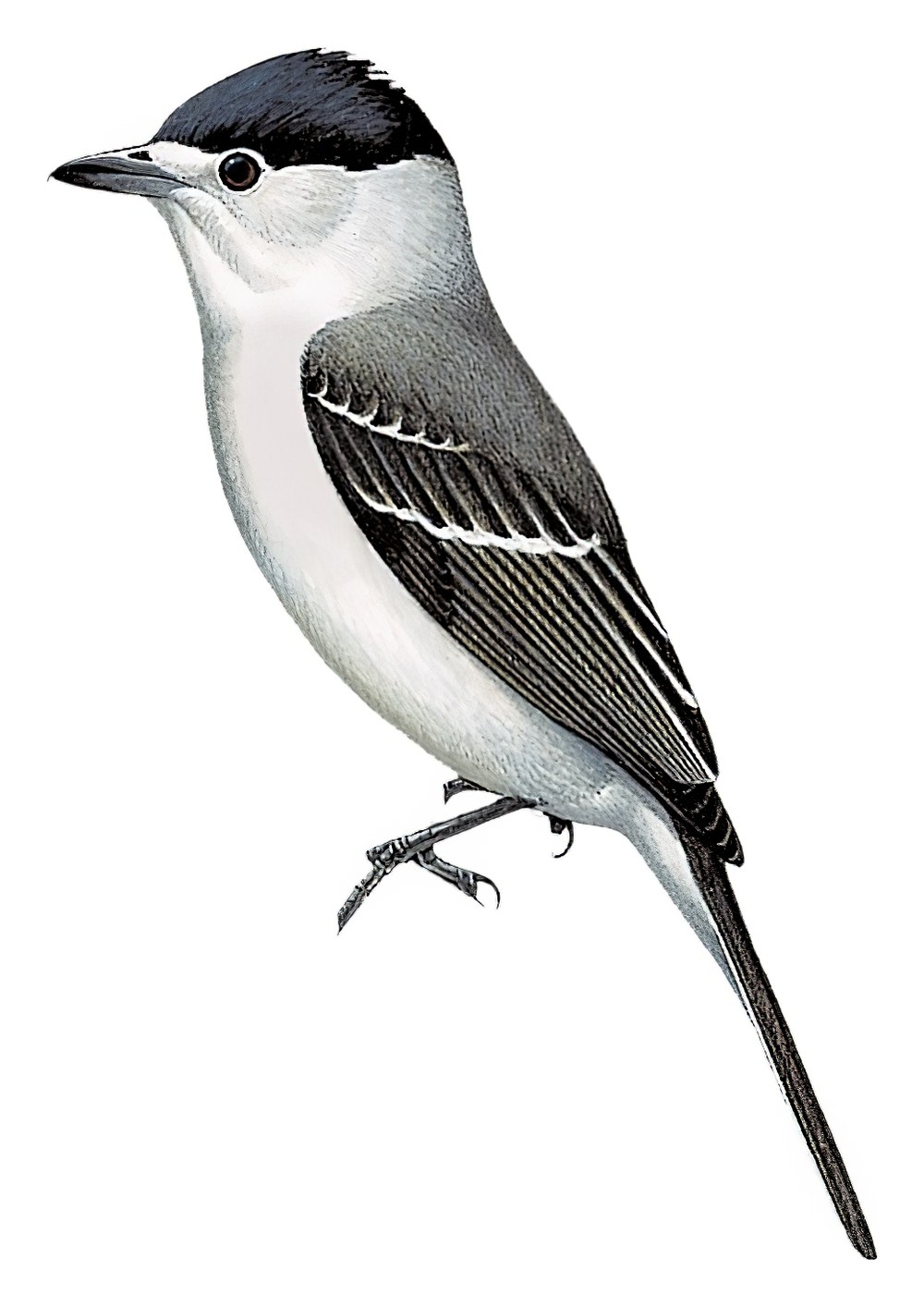White-naped Xenopsaris / Xenopsaris albinucha

White-naped Xenopsaris
SCI Name:
Protonym: Pachyrhamphus albinucha Proc.Zool.Soc.London(1868) (1868), Pt3 p.635
Taxonomy: Passeriformes / Tityridae / Xenopsaris
Taxonomy Code: whnxen1
Type Locality: sedges of shores of Rio de la Plata, near Buenos Aires, Argentina.
Author: Burmeister
Publish Year: 1869
IUCN Status: Least Concern
DEFINITIONS
XENOPSARIS
(Tityridae; Ϯ White-naped Becard X. albinucha) Gr. ξενος xenos stranger; genus Psaris Cuvier 1817, tityra; "Pachyrhamphus albinucha, having a pycnaspidian tarsus, is a member of the family Cotingidæ; but it is so different in other points of its structure from the typical members of the genus in which it was placed by its describer that there can be no question it does not belong there. ... but on comparison with the various genera in this and other "subfamilies" it is found to approach more nearly to Casiornis in structure than to any other. The differences, however, from Casiornis, are so numerous and so great, that there seems to be no resource but to establish a new genus for its reception. I, therefore, propose as the name for the new genus the name Xenopsaris. The characters of the genus and its type species are as follows: Xenopsaris genus novum Cotingidarum. (Type, Pachyrhamphus albinucha Burmeister.) GEN CHAR.: Similar to Casiornis Bp., but bill very much smaller, narrower, and more elevated at the base, with culmen gradually curved thoughout its length; nasal and rictal bristles much less developed; tail nearly as long as the wing, emarginate and rounded (i.e., double-rounded), the feathers rather narrow; primaries exceeding secondaries by more than length of bill; the second, third, and fourth quills nearly equal, and longest; first primary equal to sixth; tarsus about equal to length of bill measured from the rictus; middle toe considerably shorter than tarsus (slightly less than exposed culmen); feathers of pileum lengthened and broad, forming when erected a full, rounded crest; along each side of the lower back and rump a conspicuous tuft of pure white cottony feathers. Color (both sexes) grayish above, with glossy black, full-crested pileum, the lower parts, sides of head (below eyes), nuchal collar, lores, and frontlet, white. Xenopsaris albinucha (BURM.). ... This small bird lives in the sedge of the shores of the Rio de la Plata, near Buenos Ayres, and has a somewhat melancholy temperament, sitting quite still in the same place a long time." (Ridgway 1891). The White-naped Becard or Xenopsaris was formerly variously considered to be a member of the Cotingidae or of the Tyrannidae.
Synon. Prospoietus.
albinucha / albinuchalis
L. albus white; Med. L. nuchus nape < Arabic nukhā' spinal marrow.
SUBSPECIES
White-naped Xenopsaris (albinucha)
SCI Name: Xenopsaris albinucha albinucha
albinucha / albinuchalis
L. albus white; Med. L. nuchus nape < Arabic nukhā' spinal marrow.
White-naped Xenopsaris (minor)
SCI Name: Xenopsaris albinucha minor
minor
L. minor smaller < comp. parvus small. “Comparative names ... Specific names expressive of comparative size are also to be avoided, as they may be rendered inaccurate by the after-discovery of additional species. The names ... maximus, minor, minimus, etc. are examples of this objectionable practice” (Strickland Code 1842).
● ex “Short-eared Owl” of Pennant 1761 (syn. Asio flammeus).
● ex “Little Thrush” of Catesby 1731-1743, Edwards 1758-1764, Latham 1783, and Pennant 1785, “Turdus iliacus carolinensis” of Brisson 1760, and “Grivette de l’Amérique” of de Buffon 1770-1783 (syn. Catharus fuscescens).
● ex “Whip-poor-will” of Catesby 1731 (Chordeiles).
● ex “Coucou des palétuviers de Cayenne” of d’Aubenton 1765-1781, pl. 813, “Petit Vieillard” of de Buffon 1770-1783, and “Mangrove Cuckow” of Latham 1782 (Coccyzus).
● "54. PICUS. ... minor. 12. P. albo nigroque varius vertice rubro, ano albido. Picus albo nigroque varius, rectricibus tribus lateralibus seminigris. Fn. svec. 83. Hasselqv. iter. 242. Picus varius tertius. Raj. av. 43. Picus varius minor. Alb. av. I. p. 20. t. 20. Habitat in Europa.” (Linnaeus 1758) (Dryobates).
● ex “Fregata minor” of Brisson 1760, “Petite Frégate” of de Buffon 1770-1783, “Man of War Bird” of Edwards 1760, and “Lesser Frigate Pelican” of Latham 1785 (Fregata).
● ex “Petit Indicateur” of Levaillant 1807, pl. 242 (Indicator).
● ex “Pie-grièsche d’Italie” of d’Aubenton 1765-1781, pl. 32, fig. 1 (Lanius).
● ex “Perruche à ailes noires” of de Buffon 1770-1783, “Petite perruche de l’isle de Luçon, 4ème ésp.” of Sonnerat 1776, and “Luzonian Parrakeet” of Latham 1781 (syn. Loriculus philippensis).
● ex “Apiaster Philippensis minor” of Brisson 1760 (syn. Merops viridis americanus).
● ex “Little Woodcock” of Pennant 1785, and Latham 1785 (Microptera).
● ex “Troupiale de la Caroline” of d’Aubenton 1765-1781, pl. 606, fig. 1, “Petit Troupiale noir” of de Buffon 1770-1783, and “Lesser black Oriole” of Latham 1782 (syn. Molothrus ater).
● ex “Lesser Bird of Paradise” of Latham 1783 (Paradisaea).
● ex “Barbican à ventre rose” of Levaillant 1806 (Pogonornis).
● ex “Porphyrio minor” of Brisson 1760 (syn. Porphyrula martinica).
● ex “Colymbus fluviatilis” of Brisson 1760 (syn. Tachybaptus ruficollis).
● ex “Huppe d’Afrique” of Audebert & Vieillot 1800-1802 (syn. Upupa africana).
● ex “Ringvia” of Brünnich 1764, and “Lesser Guillemot” of Pennant 1785 (syn. Uria aalge).
UPPERCASE: current genus
Uppercase first letter: generic synonym
● and ● See: generic homonyms
lowercase: species and subspecies
●: early names, variants, mispellings
‡: extinct
†: type species
Gr.: ancient Greek
L.: Latin
<: derived from
syn: synonym of
/: separates historical and modern geographic names
ex: based on
TL: type locality
OD: original diagnosis (genus) or original description (species)












